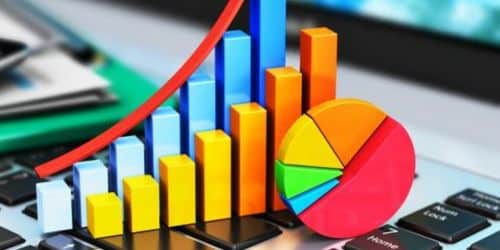Many businesses utilize statistical analysis to organize the collected data and forecast future trends. Despite the fact that businesses have a wide range of alternatives for what to do with their big data, statistical analysis provides a means to assess the data both as a whole and as individual samples. Statistics are at the heart of efficient company intelligence. We’ve put up this primer to assist you in understanding how to perform statistical analysis, its main purpose, and how it could benefit your company. It also includes some of the most widely used statistical analysis tools available today.
Statistical Analysis
Statistical analysis is the process of gathering and analyzing data in order to find patterns and trends, get rid of bias, and help make decisions. It is a part of business intelligence that includes the gathering, examining, and disclosing of market data and trends. Businesses can benefit from statistical analysis in a number of ways, including finding the top-performing product lines, locating ineffective salespeople, and discovering how sales performance varies across the nation.
Statistical analysis approaches can aid in the development of predictive models. Instead of offering simple trend estimations that may be altered by a number of external factors, statistical analysis tools allow businesses to go deeper and evaluate more data.
Statistical Analysis’s Advantages
General statistics can be used by business managers to identify trends that might otherwise go unnoticed. Additionally, the study offers decision-making objectivity. Using reliable data eliminates the need for intuition. Here are a few particular advantages of statistical analysis for a company:
#1. Reduce operating expenses
Using statistical analysis, organizations can identify spending trends and conduct more precise cost and data investigations. Businesses may derive insights about prospective future expenditures or cost-cutting measures to control spending and reduce waste after appropriately detecting this information.
You’ve been thinking about renting a vending machine for the lobby so that guests and employees have easy access to drinks and snacks, but you’re not sure if it will be in use often enough to be profitable. The frequency of sales, the money generated, the machine’s purchase price and the expense of maintaining it stocked may all be compared using statistical analysis. The equipment is probably underutilized, so eliminating it from your budget won’t have a detrimental effect on how your business operates.
#2. Investigate the market
Businesses can undertake accurate market studies with the aid of statistical analysis. The data can demonstrate where sales are most profitable, where they happen most frequently, and what marketing is associated with those transactions. It enables all facets of sales and marketing to function more successfully. Consider a businessman who now owns a prosperous café and wants to expand. The business might do a market analysis to assess possible consumer preferences, local disposable income, and foot traffic in a specific location. The information that amply supports the potential location’s viability enables the business owner to make an informed choice.
#3. Boost productivity at work
Statistical analysis can help enhance productivity at work. For instance, we are aware that giving employees the proper tools may help them do their best work. Employers can analyze each tool’s usefulness using statistical analysis and concentrate on those that best support performance. Business leaders can also use statistical research to pinpoint factors, such as whether or not coworkers have lunch together or participate in employee networking events, that may boost or lower workplace productivity.
Measuring employee output after implementing a new tool or practice would be a helpful example of using statistical analysis to evaluate workplace efficiency. For instance, a business could investigate if office virtualization boosts employee productivity.
#4. Make better decisions
The basis of business intelligence and informed decision-making is statistical analysis. The results of A/B testing and descriptive statistics offer a clear picture of the options that leads or customers prefer. This is crucial for companies that struggle to attract customers consistently as well as for those looking to diversify their product offerings or client groups.
Before making important business decisions, you should try out a new idea and look at the results. Redesigning websites is one instance of this. A company should first soft-launch a prospective new design to a limited sample of users in an A/B test rather than launch a completely new website. Through this procedure, the company is able to gather crucial data regarding website usage, possible click-through rates, and whether the new design resulted in an increase or drop in sales. By comparing these numbers to those of the old site, they can decide if the redesign should be fully put into place, changed, or thrown out.
#5. Statistical Analysis Software
Because no one can accurately do extremely complex statistical calculations, statistical analysis is a time- and money-consuming process. Software for statistical analysis has grown to be a crucial tool for businesses. The software does complex computations, recognizes trends and patterns, and properly generates charts, graphs, and tables in a matter of minutes using artificial intelligence and machine learning.
Statistical Analysis Methods
There are many ways to analyze data, but the following are the five most common and widely used statistical analysis techniques:
#1. Mean
One of the approaches used most frequently is the mean, also referred to as the average mean. The mean, which is relatively easy to calculate, determines the overall trend of the data. The mean is calculated by adding together each value in the data set and dividing it by the total number of data points. Despite its simplicity and advantages, the mean should not be used as the main statistical indicator because doing so can lead to erroneous inferences.
#2. Standard Deviation
A different method or statistical tool that is very popular is the standard deviation. It examines how far each individual data point deviates from the collection’s mean value. The data collection shows how far apart the data are from the mean. It can be employed to assess how generalizable the research findings are.
#3. Regression
Regression is a statistical technique that aids in determining the cause-and-effect relationship between the variables. The causal link between a dependent variable and an independent variable is established. Future trends and occurrences are regularly predicted using it.
#4. Evaluating theories
A conclusion or argument can be put to the test by being compared to a collection of data through hypothesis testing. The results of the research will indicate whether or not the initial notion was correct.
#5. Identify the sample size
To select a sample from the total population that is representative of the population, procedures like sample size estimation or data sampling are used. When the population is extremely huge, this strategy is employed. Other methods of gathering data exist, including convenience sampling, random sampling, and snowball sampling.
Types of Statistical Analysis
The following are the six statistical analysis categories:
Detailed Analysis
Data must be gathered, understood, summarized, and statistically analyzed before being presented as tables, charts, and graphs. It just makes the challenging information easy to read and understand without offering any conclusions.
Inferential Analysis
An inferential statistical study’s main goal is to draw conclusive conclusions from the data being examined. It investigates the connections between various components or makes general population predictions.
Statistics for Analysis
A sort of statistical analysis called predictive statistical analysis looks at data to identify historical trends and makes predictions about the future based on those trends. Data statistical analysis is done using machine learning, data mining, and artificial intelligence approaches.
Prescriptive Analysis
The prescriptive analysis looks at the data and advises the appropriate course of action in light of the findings. It is a type of statistical investigation that backs up opinion.
Exploratory Data Analysis
In contrast to inferential analysis, which focuses on known data connections, exploratory analysis involves examining unknown data linkages. It examines any connections that the data might have.
Causal Analysis
To determine the causal relationships between the many variables included in the raw data, use causal statistical analysis. It establishes the cause of an occurrence and how it had an impact on other factors, to put it simply. Businesses might utilize this process to figure out why something failed.
How to Perform Statistical Analysis?
Getting reliable results from statistical analysis needs careful planning from the start of the research process. You must decide on your study’s design, sample size, and sampling procedure in addition to creating your hypothesis.
After gathering data from your sample, you can organize and synthesize the data using descriptive statistics to perform statistical analysis. After that, you can formally test hypotheses and offer population estimates using inferential statistics. Finally, you can generalize your results and perform analysis through the statistical analysis process below:
#1. Make a hypothesis and organize your research strategy
You must first openly state your hypothesis and map out your research strategy in order to gather reliable data for statistical analysis. The traditional objective of a link between variables within a population. Statistical analysis can be used to test a hypothesis. A structured population forecast is a statistical hypothesis. Every research hypothesis is transformed into a null and a rival hypothesis that may be verified with sample data.
The alternative hypothesis describes your research’s prediction of an effect or relationship, whereas the null hypothesis consistently predicts no effect or relationship between variables.
#2. Gather information from a sample
In most cases, it would be impractical or prohibitively expensive to collect information from every member of the population of interest. Instead, you will gather information using a sample. With the proper sampling techniques, statistical analysis allows you to deduce your results from your own sample. A sample that is typical of the population is what you need.
#3. Create a descriptive statistical summary using your data
You can examine your data when you’ve collected it all and give statistics that describe it. You can evaluate the distribution of your data, including whether it is skewed or normal, and whether any outliers or missing data exist, by presenting your data in tables and graphs.
#4. Utilize inferential statistics to generate estimations or test hypotheses
A parameter is a number that describes a population, as opposed to a statistic, which is a number that describes a sample. Inferential statistics can be used to make conclusions about population parameters based on sample statistics.
#5. Describe your findings
The primary standard for drawing inferences from hypothesis testing is statistical significance. To determine if your results are statistically significant or not, you must compare your p-value to a predetermined significance level (often 0.05). Results that are statistically significant cannot have happened by chance alone, according to broad consensus.
To learn more on How to perform statistical analysis Read: DATA ANALYSIS PROCESS: Methods, Process, And Types
What Is the Main Purpose of Statistical Analysis?
Statistical analyses are used in almost all fields to make sense of the vast amount of data that is available. The main purpose of statistical analysis involves collecting and analyzing data to find patterns and trends.
Even if the field of statistics is not your primary field of study, it can help you make an impact in your chosen field. Chances are very high that you’ll need working knowledge of statistical methodology both to produce new findings in your field and to understand the work of others. Conversely, as a statistician, there is a high demand for your skills in a wide variety of areas: universities, research labs, government, industry, etc. Furthermore, statistical careers often pay quite well.
What is the importance of statistical analysis and business intelligence?
Sustainability depends on business intelligence, of which statistical analysis is only one component. Without periodically reviewing their business, a business owner cannot successfully manage issues, repeat successes, or make future plans. Businesses should constantly evaluate themselves to gain a better grasp of the organization.
What is the purpose of statistical analysis?
The gathering and evaluation of data for statistical analysis are done to find patterns and trends. It belongs to data analytics. In instances like obtaining research interpretations, statistical modeling, or creating surveys and studies, statistical analysis might be applied.
What is an ANOVA test in statistics?
A statistical technique called analysis of variance, or ANOVA, divides observed variance data into various components for use in further testing. When there are three or more data groups, a one-way ANOVA is used to find out how the dependent and independent variables are related.
Which tool is best for statistical analysis?
Software for Statistical Analysis:
- JMP
- Posit
- Minitab Statistical Software
- SPSS Statistics
- OriginPro.
- reviews.
- Base SAS.
- Stata.
Is statistical analysis quantitative or qualitative?
A categorical variable’s data will always be qualitative, while a numeric variable’s data will always be quantitative. As a result, based on whether the variable is numeric or categorical, you can determine the type of data before it is collected.
Bottom Line
Almost every discipline now uses statistical methods to make sense of the mountain of data at their disposal. Even if statistics isn’t your major, learning the fundamentals can give you an edge in any career. There is a significant likelihood that you will need familiarity with statistical methodology/analysis in order to undertake original research and to comprehend the findings of others in your profession, you need to know its main purpose and how to perform it.
Statistical Analysis FAQs
How to Perform Statistical Analysis?
To perform statistical analysis and get reliable results, it needs careful planning from the start of the research process. You must decide on your study’s design, sample size, and sampling procedure in addition to creating your hypothesis.
What Is the Main Purpose of Statistical Analysis?
Statistical analyses are in use in almost all fields to make sense of the vast amount of data that is available. The main purpose of statistical analysis involves collecting and analyzing data to find patterns and trends.
References
Related Articles
- DATA ANALYST: Overview, Salary, Job, Resume & All You Need
- MARKETING RESEARCH PROCESS: Detailed Guide
- TECHNIQUES FOR DATA MINING to Scale any Business in 2022
- Predictive Analytics: Definition, Examples, and Benefits
- Demand Planning: Overview, Comparisons, Salaries & Jobs
- Statistical Tests: What They Mean, Examples, and Types






